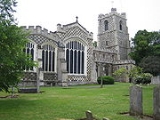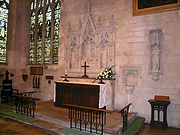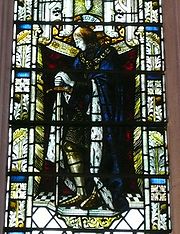
St Mary's, Luton
Encyclopedia
St Mary's, Luton, is an Anglican Church
in the centre of the town of Luton
, England
. The church has a rich and long history, being over 850 years old and has been rebuilt and refurbished constantly over the centuries. The Church is one of the largest in Bedfordshire
and considered a fine example of medieval architecture
.
The Church is part of the St Albans
Diocese.
as an act of thanksgiving for victory over the Danes. The land here was owned by the king in Saxon
and early Norman
times and the church was very richly endowed.
in 1121 and consecrated in 1137. The original structure of the church was a cruciform
without aisles, but with the increases in population, the north and south aisles were added within 40 years of each other at the turn of the 13th century.
with an upper room was built north of the chancel and a new font
was given a unique canopy of richly carved stone in an octaganol shape.

 A lot of restoration
A lot of restoration
and rebuilding work was carried out in this time, with Someries chapel
being extended, the sacristy being re-built further east and the west tower made taller and having most of the windows renewed. All this work was carried out with the help of Lord John Wenlock
, whose family had been connected with the church since 1389. In 1461 the chapel was renamed the Wenlock Chapel, and William Wenlock (father of John) is one of three people interred there.
work began to help restore the church to its full glory. The distinctive flint
and stone
chequer was extended to cover most of the church and the tower was restored in 1906 and the Wenlock chapel was also restored in 1914. In the 1960s, offices, halls and vestries were built in the chequered style to provide more space and the Magnificat Window in the south transept was installed in 1979.
itself was installed in 1901, and faced west across the town. However, after two overhauls in 1909 and 1949, which included the installation of a new bell, the clock's mechanism's seized and gave up in 1979. The bell was not heard for 28 years, until the University of Bedfordshire
(formerly of Luton), decided to offer to help restore the clock, ready for the new year and the millennium. The university owned buildings next to the church and decided it was time to restore the clock to its former glory. The clock was officially re-opened on November 11, 1999, Armistice Day
.
The project will integrate the churchyard into the neighbouring streets to create a large public space.
The graveyard in the direct vicinity of the church is no longer used, but a cemetery that covers most of St Anne's hill, the Luton Church Cemetery, is about a mile from the church, heading up to Crawley Green
.
Church Body
A local church is a Christian religious organization that meets in a particular location. Many are formally organized, with constitutions and by-laws, maintain offices, are served by pastors or lay leaders, and, in nations where this is permissible, often seek seek non-profit corporate status...
in the centre of the town of Luton
Luton
Luton is a large town and unitary authority of Bedfordshire, England, 30 miles north of London. Luton and its near neighbours, Dunstable and Houghton Regis, form the Luton/Dunstable Urban Area with a population of about 250,000....
, England
England
England is a country that is part of the United Kingdom. It shares land borders with Scotland to the north and Wales to the west; the Irish Sea is to the north west, the Celtic Sea to the south west, with the North Sea to the east and the English Channel to the south separating it from continental...
. The church has a rich and long history, being over 850 years old and has been rebuilt and refurbished constantly over the centuries. The Church is one of the largest in Bedfordshire
Bedfordshire
Bedfordshire is a ceremonial county of historic origin in England that forms part of the East of England region.It borders Cambridgeshire to the north-east, Northamptonshire to the north, Buckinghamshire to the west and Hertfordshire to the south-east....
and considered a fine example of medieval architecture
Architecture
Architecture is both the process and product of planning, designing and construction. Architectural works, in the material form of buildings, are often perceived as cultural and political symbols and as works of art...
.
The Church is part of the St Albans
St Albans
St Albans is a city in southern Hertfordshire, England, around north of central London, which forms the main urban area of the City and District of St Albans. It is a historic market town, and is now a sought-after dormitory town within the London commuter belt...
Diocese.
Original church
The site of St Mary's has been the centre of worship for people in the area for over 1,000 years, and a church was built in about 930 AD by King AthelstanAthelstan of England
Athelstan , called the Glorious, was the King of England from 924 or 925 to 939. He was the son of King Edward the Elder, grandson of Alfred the Great and nephew of Æthelflæd of Mercia...
as an act of thanksgiving for victory over the Danes. The land here was owned by the king in Saxon
Anglo-Saxons
Anglo-Saxon is a term used by historians to designate the Germanic tribes who invaded and settled the south and east of Great Britain beginning in the early 5th century AD, and the period from their creation of the English nation to the Norman conquest. The Anglo-Saxon Era denotes the period of...
and early Norman
Normans
The Normans were the people who gave their name to Normandy, a region in northern France. They were descended from Norse Viking conquerors of the territory and the native population of Frankish and Gallo-Roman stock...
times and the church was very richly endowed.
12th century
The current site of the church itself was built by Robert, 1st Earl of GloucesterRobert, 1st Earl of Gloucester
Robert Fitzroy, 1st Earl of Gloucester was an illegitimate son of King Henry I of England. He was called "Rufus" and occasionally "de Caen", he is also known as Robert "the Consul"...
in 1121 and consecrated in 1137. The original structure of the church was a cruciform
Cruciform
Cruciform means having the shape of a cross or Christian cross.- Cruciform architectural plan :This is a common description of Christian churches. In Early Christian, Byzantine and other Eastern Orthodox forms of church architecture this is more likely to mean a tetraconch plan, a Greek cross,...
without aisles, but with the increases in population, the north and south aisles were added within 40 years of each other at the turn of the 13th century.
14th century
This was a time of great extension to the church, with a tower being built, transepts being extended, with twin arches opening into the new chapels on their east side. A vaulted sacristySacristy
A sacristy is a room for keeping vestments and other church furnishings, sacred vessels, and parish records.The sacristy is usually located inside the church, but in some cases it is an annex or separate building...
with an upper room was built north of the chancel and a new font
Baptismal font
A baptismal font is an article of church furniture or a fixture used for the baptism of children and adults.-Aspersion and affusion fonts:...
was given a unique canopy of richly carved stone in an octaganol shape.
15th century


Building restoration
Building restoration describes a particular treatment approach and philosophy within the field of architectural conservation. According the U.S...
and rebuilding work was carried out in this time, with Someries chapel
Chapel
A chapel is a building used by Christians as a place of fellowship and worship. It may be part of a larger structure or complex, such as a church, college, hospital, palace, prison or funeral home, located on board a military or commercial ship, or it may be an entirely free-standing building,...
being extended, the sacristy being re-built further east and the west tower made taller and having most of the windows renewed. All this work was carried out with the help of Lord John Wenlock
John Wenlock, 1st Baron Wenlock
Sir John Wenlock KG was an English soldier, courtier and politician. He fought on the side of both the Yorkists and the Lancastrians in the Wars of the Roses...
, whose family had been connected with the church since 1389. In 1461 the chapel was renamed the Wenlock Chapel, and William Wenlock (father of John) is one of three people interred there.
19th and 20th centuries
Again, in this time, restorationVictorian restoration
Victorian restoration is the term commonly used to refer to the widespread and extensive refurbishment and rebuilding of Church of England churches and cathedrals that took place in England and Wales during the 19th-century reign of Queen Victoria...
work began to help restore the church to its full glory. The distinctive flint
Flint
Flint is a hard, sedimentary cryptocrystalline form of the mineral quartz, categorized as a variety of chert. It occurs chiefly as nodules and masses in sedimentary rocks, such as chalks and limestones. Inside the nodule, flint is usually dark grey, black, green, white, or brown in colour, and...
and stone
Masonry
Masonry is the building of structures from individual units laid in and bound together by mortar; the term masonry can also refer to the units themselves. The common materials of masonry construction are brick, stone, marble, granite, travertine, limestone; concrete block, glass block, stucco, and...
chequer was extended to cover most of the church and the tower was restored in 1906 and the Wenlock chapel was also restored in 1914. In the 1960s, offices, halls and vestries were built in the chequered style to provide more space and the Magnificat Window in the south transept was installed in 1979.
Clock of St Mary's
The clockClock
A clock is an instrument used to indicate, keep, and co-ordinate time. The word clock is derived ultimately from the Celtic words clagan and clocca meaning "bell". A silent instrument missing such a mechanism has traditionally been known as a timepiece...
itself was installed in 1901, and faced west across the town. However, after two overhauls in 1909 and 1949, which included the installation of a new bell, the clock's mechanism's seized and gave up in 1979. The bell was not heard for 28 years, until the University of Bedfordshire
University of Bedfordshire
The University of Bedfordshire is based in Luton and Bedford, the two largest towns in the English county of Bedfordshire. The university was created by the merger of the University of Luton and the Bedford campus of De Montfort University on 1 August 2006 following approval by the Privy Council...
(formerly of Luton), decided to offer to help restore the clock, ready for the new year and the millennium. The university owned buildings next to the church and decided it was time to restore the clock to its former glory. The clock was officially re-opened on November 11, 1999, Armistice Day
Armistice Day
Armistice Day is on 11 November and commemorates the armistice signed between the Allies of World War I and Germany at Compiègne, France, for the cessation of hostilities on the Western Front of World War I, which took effect at eleven o'clock in the morning—the "eleventh hour of the eleventh day...
.
The present
The church has just finished installing a projection screen to help with the preaching of the sermon, moved the pulpit to its former position and renovated the heating system.The future
The area next to St Mary’s Church is due to be regenerated. A planning proposal has been made by Ballymore Properties Limited to build a new shopping centre opposite the church on the Power Court industrial area (previously an electrity power station, hence the areas name). As part of this project and in conjunction with Luton Borough Council, local businesses as well as other interested groups St Mary's Road and Church Street are due to be transformed, in the words of Ballymore "into high quality town centre shopping and leisure facilities, together with new affordable & private homes". (see also http://www.lutonpowercourt.com)The project will integrate the churchyard into the neighbouring streets to create a large public space.
Architecture
The architecture of St Mary's is varied as the church has been renovated and rebuilt many times, but the basic layout is that of a cruciform, with north/south aisles and many chapels and extensions in various directions heading off the main church. The total length of the church is 53 m (174 ft), the total width is 17 m (57 ft), and the height is 27 m (90 ft). The outside of the church is clad in a distinctive flint and stone chequer, which makes the church stand out in the town.The graveyard in the direct vicinity of the church is no longer used, but a cemetery that covers most of St Anne's hill, the Luton Church Cemetery, is about a mile from the church, heading up to Crawley Green
Crawley Green
Crawley Green is a ward in the southern part of Luton near to London Luton Airport. The area was historically owned by the Crawley Family, owners of the now demolished Stockwood House and Stockwood Park....
.

